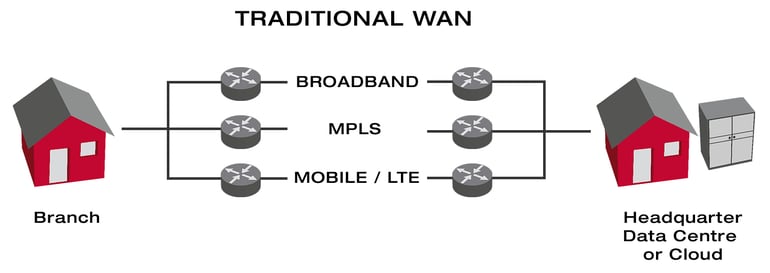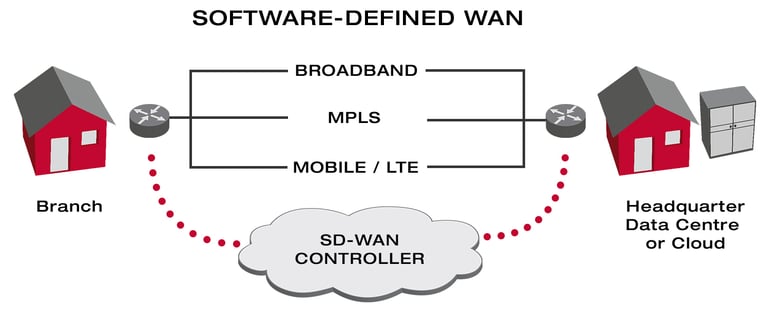For years, software-defined networking (SDN) and network functions virtualisation (NFV) have symbolised innovative change in the network industry, using software to turn classic network business upside down. New, innovative approaches offering tremendous agility and savings have come to the market, changing the way we deploy, operate and maintain networks. In the area of WAN connectivity, new software-based solutions offer significant improvements to areas such as automation, visibility and defence.
But unlike hardware, software cannot be manipulated or repaired with a screwdriver. The complexity of many software solutions and the lack of skilled resources are contributory reasons why so many companies still feel inhibited from implementing innovative solutions. Which in turn means that many companies are still struggling with today’s everyday business challenges: an ever-increasing demand for flexibility, bandwidth, connectivity and IT services, in addition to the absence of specialised personnel and fierce competition, not to mention the need to make savings in a cloud-centric business world.
In this tech blog, we would like to introduce you to the benefits of software-defined wide-area network (SD-WAN) technology, which helps service providers to evolve their WAN connectivity offerings.
Where we are coming from: traditional WAN
A wide area network (WAN) network service connects various branches across a large geographic area and provides connectivity to essential IT services provided by the headquarters data centre. It also enables access to cloud services as, over recent years, more and more companies are shifting their applications into the cloud. In the past, there have been two significant implementations for companies delivering WAN connectivity to remote sites. These were, leasing a private line to get access to the service provider’s private multi-protocol label switching (MPLS) network and, building an end-to-end VPN tunnel over the public internet. Both options still work today and can be implemented using stable and well-developed solutions. Nevertheless, deploying a traditional WAN setup comes with the following drawbacks:
- The high effort involved in managing distributed configurations and policies
The deployment of a traditional WAN usually incudes multiple network components which need to be set up at the branches and the data centre with a box or even port-related configuration. Although there are traditional solutions available, which already include automation, it takes a lot of effort to implement this functionality within the entire deployment and management process. As a result, automation is usually not used, leading to the manual processing of distributed configurations performed by highly-skilled engineers who have precise knowledge of the specific components. Therefore, a traditional WAN is highly complex and creates a heavy workload when deploying in new remote locations, carrying out changes or keeping up with essential security updates – even if templates are being used, someone still needs to access and check every single network component. - High operational costs and dependencies
In a traditional WAN set-up, a company typically connects their remote offices with the headquarters data centre through leased multi-protocol label switching (MPLS) lines. These MPLS bandwidths are expensive in comparison to regular Internet connectivity and, due to the costs, the connection is often deployed non-redundant which leads to potential single points of failure. The MPLS service itself provides high network performance, but the overlaying services are limited to the network’s reachability and, in the case of a failure, an incident requires intensive troubleshooting. - Performance penalties through backhauling
In a traditional WAN set-up, traffic is typically backhauled to the central data centre which leads to sub-optimal routing and potential performance losses, especially for the use of cloud services. The reason usually is that security appliances centrally placed in the headquarters data centre perform an in-depth inspection of the traffic before the data is handed off.
As you can see, these constraints lead to a lack of agility, resulting in high operational cost for service providers and also their customers. The effort required to implement, operate and maintain a traditional WAN connection is high and uses up valuable resources because of lack of automation, performance visibility, enhanced security features and intelligent traffic management.
What is an SD-WAN?
While SDN in general focuses more on data centres and campus networks, SD-WAN is a software-defined application for the delivery of WAN connectivity services with centralised control and the separation of the data, control and management planes, as we already know from high-end routers. The management plane is typically provided through the vendor-specific customer portal, or an enterprise developed integrated system portal which is the plane between the policy engine and the controllers. The software-defined approach simplifies the implementation and management of the WAN connectivity and comes with many benefits that give your business the agility to compete in today’s digital world:
- Simplicity through abstraction, automation and centralised control
The SD-WAN controller centralises all the WAN service provisioning and management. Depending on the SD-WAN solution you implement, it comes with centralised policy enforcement, automated and efficient path selection, content filtering and network analytics and monitoring. You will have one out-of-the-box central control management system where you can, for example, define your traffic engineering rules, and the controller deploys these changes automatically to all the required network devices. While in the past network operators used a lot of effort to develop this simplification themselves, this functionality is now included in new SD-WAN solutions so that you can get started immediately. In this way, the operational complexity is significantly reduced, giving you the ability to free your network engineering resources for business-critical work. SD-WAN solutions offer a new abstraction level with a high degree of automation, helping to lower operational costs because implementation and change can be more agile. SD-WAN solutions also bring better network and application performance visibility and a detailed picture of the network’s health. - High degree of flexibility and simplicity
A major benefit of SD-WAN solutions is zero touch provisioning (ZTP), which addresses a serious network operator pain point. ZTP simplifies the installation and activation process so that even a non-technical person can commission any CPE which is sent to the remote site. For example, the activation can be done through an SMS authentication code or a URL activation via E-MailSD-WAN also comes with a high degree of flexibility as it permits combining internet connections (even LTE), as well as traditional MPLS traffic routes, into virtual connections, thus eliminating the need for swinging traffic to a backup link in case of a circuit outage. Traffic is automatically divided and prioritised on the existing connections so that non-critical traffic no longer burdens leased MPLS lines. This intelligent traffic management makes the network more reliable and flexible. In this way, service providers can offer customers the best and most cost-effective way of connecting branches. - Optimised security – encrypted tunnels and intelligent traffic offload
Of course, customers don’t want to send business-critical data through the Internet without protection. These security concerns are addressed in many SD-WAN solutions as they provide an option for end-to-end encryption through encrypted tunnels. You can set up these tunnels via the centralised management and, in combination with policies, this also allows you to offload traffic through an encrypted internet path. This option offers enormous flexibility for intelligently dividing traffic by using policies. For example, nightly backups can be sent over a secure Internet connection without straining the main line the customer needs for business-critical applications. These benefits give the service provider’s customers additional resiliency and improves their network connectivity at the branch.
In this tech blog, we have given a short introduction comparing SD-WAN and its benefits to the traditional approach. All in all, SD-WAN significantly changes the management and operation of the WAN environment. In the coming weeks, we will introduce different SD-WAN solutions from Juniper Networks, Versa Networks and Nuage Networks.
Share your opinion with us!
Leave a comment using the form below and let us know what you think.
.png?width=300&height=300&name=Design%20ohne%20Titel%20(7).png)


